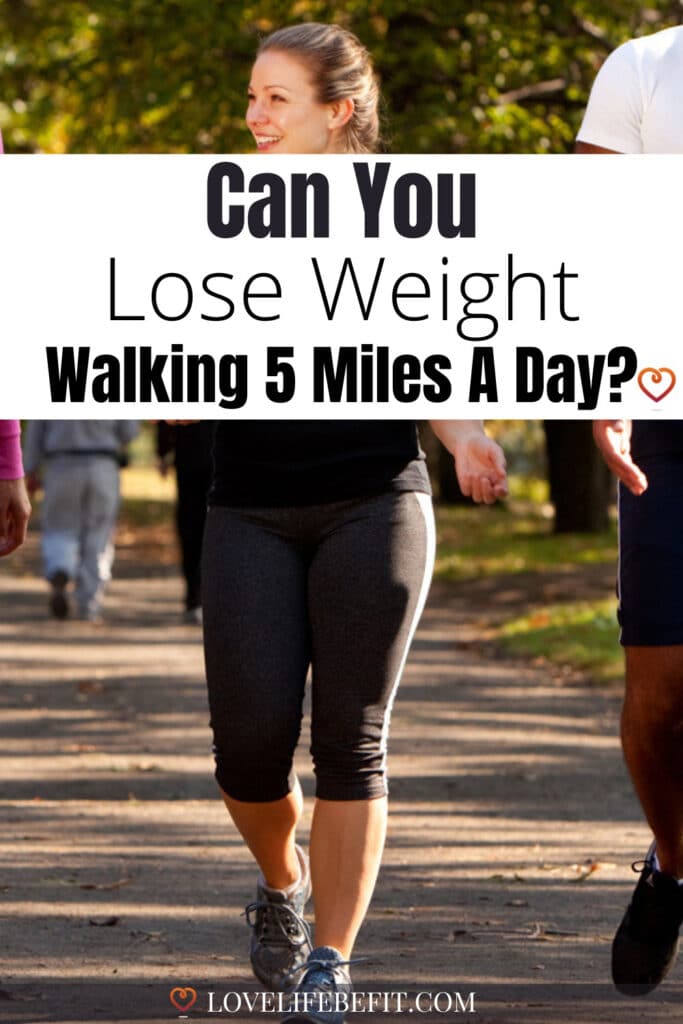Walking 5 Miles A Day: Benefits & What Happens To Your Body?
I’ve always been a walker. It’s hardly surprising when it’s the most natural form of exercise. I walked before I became a runner and it’s been my go-to form of exercise if I’m injured, overworked, or just plain tired. I find it’s one of the best ways to keep my weight in check. But how far should you walk? And is walking 5 miles a day excessive?
If you’re new to exercise, it’s not a distance I recommend on day one of your fitness program. But for those with a basic level of fitness, it won’t take long to build up to walking a regular 5-mile distance.
You don’t have to walk 5 miles all in one go. When I worked in an office, I used to walk 2 miles to work, a mile around the park during my lunch break, and 2 miles home again. While my colleagues faded with afternoon brain fog – I felt fresh and revitalized.
So let’s look at what to expect if you start walking 5 miles a day. What are the benefits, is it a good idea and what does it do to your body?

How Far Is 5 Miles?
5 miles is 8,800 yards or 8,047 meters – a little over 8 kilometers.
If you’re using a step counter or fitness tracker, the number of steps it takes to walk 5 miles will depend on fitness levels, average step length (stride length), and walking pace.
As a rough guide, walking 5 miles is equivalent to 10,000 to 12,000 steps.
The idea of walking 10,000 steps a day started as an arbitrary figure for improving general health. Turns out that it’s an excellent target. Recent studies by JAMA Neurology and JAMA Internal Medicine found that hitting 10,000 steps a day at a brisk pace reduced your risk of dementia, heart disease, cancer, and premature death.
How Long Should A 5-Mile Walk Take?
Provided you’re not hiking 5 miles in the hills or on rugged paths, most people can walk 5 miles in 75 to 90 minutes on flat terrain.
This is walking briskly, at a pace of 15 to 18 minutes per mile or an average walking speed of just over 3 to 4 miles per hour (mph).
Fitness level will be the biggest factor behind how fast you can walk but age, gender, effort level, terrain, and elevation climbed all contribute.
The weather can also affect walking pace. A brisk walk on a very hot day or in winter into driving rain or a headwind will be a lot harder than on a cool, calm summer evening.
Some people are very fast walkers and can power walk 5 miles in about an hour. This is exceptional and most fast walkers will take at least 90 minutes at a speed of 4 mph.
For others, 5 miles is a long walk and it can take two hours to cover 5 miles, walking at a speed of 2.5 mph.
When you first start walking, speed isn’t important – it’s effort level. Try and walk briskly – your heart rate will be elevated: you can still talk comfortably, but you’re making a continuous effort to keep up your speed.
The chart below shows how long it takes to walk 5 miles at different paces:
| Walking Speed (mph) | Walking Pace (min/mile) | Time Taken To Walk 5 Miles (hour: min) |
| 2.5 | 24.0 | 2:00 |
| 2.75 | 21.8 | 1:49 |
| 3.0 | 20.0 | 1:40 |
| 3.25 | 18.5 | 1:33 |
| 3.5 | 17.1 | 1:26 |
| 3.75 | 16.0 | 1:20 |
| 4.0 | 15.0 | 1:15 |
| 4.25 | 14.1 | 1:11 |
| 4.5 | 13.3 | 1:07 |
| 4.75 | 12.6 | 1:03 |
| 5.0 | 12.0 | 1:00 |
Is Walking 5 Miles A Day Enough Exercise?
Walking 5 miles a day may be enough exercise but it depends on your fitness goals.
The Centers For Disease Control and Prevention recommends 150 minutes of moderate-intensity physical activity and 2 days of strength training activity for adults every week.
That’s walking for 30 minutes a day, one to two miles, 5 days a week.
These activity levels are a bare minimum aimed at the general population.
That’s going to be better for your cardiovascular health than not exercising at all, but 5 miles a day is a far better target.
If your goal is weight loss, getting fitter, or just weight maintenance, walking 5 miles a day will help you burn calories and improve your heart health. It’s one of the easiest ways to improve your fitness. It’s accessible, suitable for both young and older adults and you don’t need an expensive gym membership – just a good pair of walking shoes.
5 miles may seem a long way, but you can split the number of miles into shorter walks and add them to your daily routine.
As you get fitter, try and walk faster – try to stay out of your comfort zone and be constantly challenged. Your body is very good at adapting to an exercise program. So, if you’re trying to lose weight, as your fitness level improves, you need to keep increasing the effort level to keep burning calories.
Add interval training where you’re walking at a faster pace for short bursts, walking up hills, or using walking poles for a full-body workout. Some people switch to running for weight loss as their fitness improves. It takes about an hour to run 5 miles.

Can I Lose Weight By Walking 5 Miles A Day?
Losing weight depends on your diet as much as exercise. Think of your walks as an aid to weight loss.
By walking 5 miles a day you’re increasing your Daily Energy Expenditure. This will help you lose weight provided you don’t replace the calorie burn from walking by eating more.
If you treat walking 5 miles a day as a green light to eat more calories – then no you won’t lose weight. You’ll get fitter and enjoy all the benefits of walking – but you’ll still be carrying extra weight.
Successful weight loss from walking 5 miles a day comes from combining exercise with a healthy diet.
On the plus side – it’s much easier to lose weight and keep it off if you combine better eating habits with following an exercise program.
Physical activity will maintain and improve your muscle mass – that’s better for daily calorie burn and will help your weight loss to be mainly body fat. If you follow a diet but don’t exercise, you risk losing muscle strength
Most people will lose one pound a week from walking 5 miles a day. If you follow my Fat Buster Walking Challenge most people lose 10 pounds over the 9-week program.
Related post: How Much Should I Walk According To My BMI?
How Many Calories Will I Burn Walking 5 Miles A Day?
Walking is a great way to burn more calories. Per mile, it’s almost as good as running with walkers burning 80 to 100 calories per mile.
The exact number of calories burned will depend on your fitness level, your walking pace, your current body weight, and the amount of time you spend walking. Use our calories burned walking 5 miles chart or our Calories Burned Walking Calculator to find out how many more calories you can burn from walking.
You can burn more calories and lose extra weight by walking faster or uphill. Just remember weight loss is only possible if you don’t reward yourself with a high-calorie treat!
One of the big pluses of starting a walking program is that the greater your starting body weight, the higher your weight loss and calories burned from exercising.
That’s because of the effort level. When you’re overweight, you’re working harder than the average person, and the calories burned will be much higher. That makes walking a great way to lose weight!
What Does Walking 5 Miles A Day Do To Your Body?
Most people benefit from steady weight loss. The numbers on the scale may not go down in the first few weeks but they do if you keep walking every day over a longer period.
The last time I followed a 5-mile-a-day schedule I was returning to fitness from a bad ankle injury. I couldn’t run so walking was my go-to exercise to keep fit and lose weight. It’s a great exercise and it works.
How much weight you lose will depend on what you eat. If you walk and make a few improvements to your diet, weight loss can be significant.
Walking will make you feel stronger. Your stomach muscles will tighten and get firmer – so you’ll look slimmer even before you hit your weight loss goals.
Your glutes get stronger from walking – expect a firm butt – plus shapely legs and great calf muscles – especially if you start walking up hills.
Jump straight into walking 5 miles a day and you can expect sore legs. It can be too far if you don’t have a walking background. Instead, follow a walking plan and build up your daily mileage and walking distance gradually.
It’s also important to make sure you have good walking shoes or trainers. You want footwear that can absorb impact if you’re walking on hard pavements.
Related post: Walking 3 Miles A Day: Benefits, Weight Loss + How To Get Started

7 Health Benefits Of Walking 5 Miles A Day
It isn’t just about calories burned, there are so many benefits to starting a walking plan:
#1 Mental Health Benefits
Walking in the fresh air can help you de-stress and clear your head. Exercise releases endorphins – those feel-good hormones that lift your mood and help to improve your mental health.
#2 Good For Your Heart Health
Regular walks help to improve your cardiovascular fitness and heart health, helping to protect you from cardiovascular disease.
#3 Improve Your Blood Glucose Levels
Use walking to improve your body’s use of insulin – reducing the risk of developing type 2 diabetes.
#4 Strengthen Your Bones
Osteoporosis can be a real problem as you get older, especially for post-menopausal women. The good news is regular walks help to strengthen your bones.
#5 Weight Loss
Walking 5 miles a day can help you lose weight. When combined with healthy eating, it’s possible to reach your weight loss goals.
#6 Improved Sleep Quality
Regular exercise helps to improve the quality of sleep. That means you’ll wake up feeling less tired and have more energy throughout the day.
#7 Lower Blood Pressure
Exercise helps to lower your blood pressure and reduce the risk of developing high blood pressure.
Find out more about how walking improves health conditions and reduces the risk of chronic diseases including certain cancers in this related post: Walking An Hour A Day: Health Benefits And Weight Loss

It takes a little time to start seeing the benefits of walking but stick to regular walks and you’ll soon get that great feeling of being fitter and full of energy!





